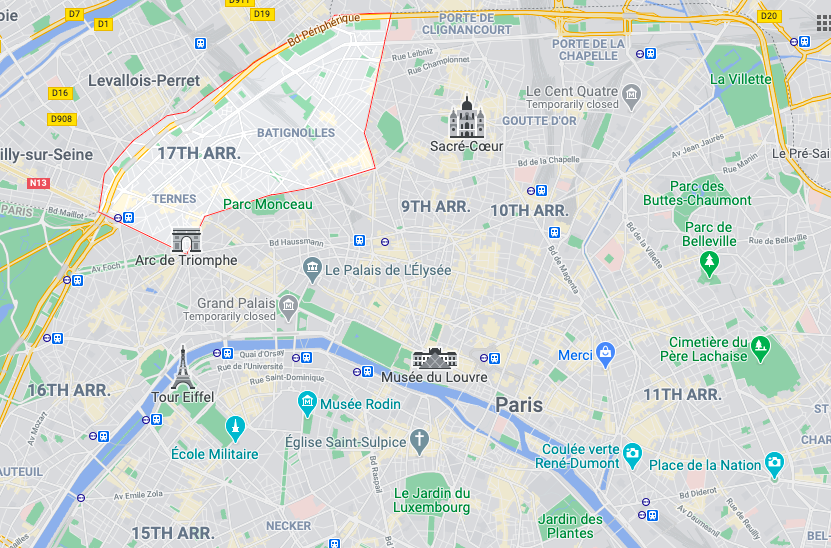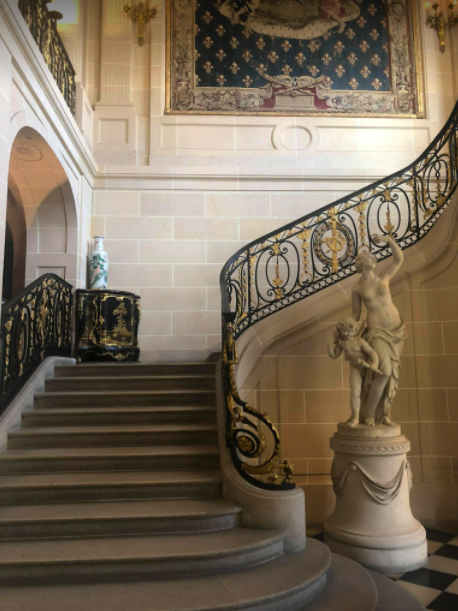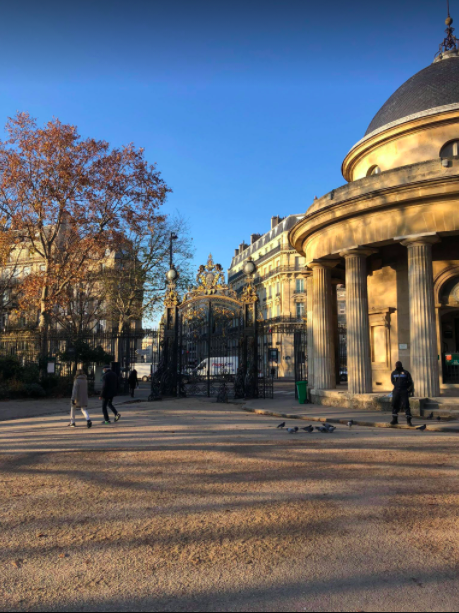75017: Not to be missed–Guide to 17th arrondissement, Paris and Parc Monceau
In the north-west of Paris, you can find the 17th arrondissement. Vast and multifaceted, this area holds within itself numerous atmospheres and landscapes, both bourgeois and popular, calm and vibrant.
No particularly famous landmarks, no crowd-filled museums or illustrious buildings, but for the true Paris-lover, le dix-septième is a must, for many reasons which this article will reveal.

The 17th arrondissement Paris: les quartiers
1. Quartier—la Plaine-de-Monceau
The first and the chicest of them, la Plaine-de-Monceau, lies to the west. And since the quarter/ neighbourhood is part in the 8th and part in the 17th, we will include here some spots located in the former as well.

The beating heart of this neighbourhood is undoubtedly the park of the same name, the beautiful Parc Monceau, with its green lanes its trees. Built in 1852, the park is home to spectacular sculptures such as the rotonde at the main entrance and the colonnade by the romantic pond the Naumachie.
Surrounding the parc are elegant buildings designed by Haussmann and some interesting museums.
The Musée Cernuschi is dedicated to Asian arts-the second most important Parisian museum with this specialisation and holds a fascinating collection of objects, sculptures, and paintings from many far eastern countries like China, Japan, and South Korea.
- Founded in 1898, the museum is housed in a mansion built by Henri Cernuschi, an Italian patriot exiled in France.
- He travelled to Asia between 1871 and 1873 and acquired over 5000 pieces of art during that time.
- He offered his tremendous collection to the city of Paris upon his death. Along with the permanent collection, the museum hosts exhibitions every year.

Nearby, another museum awaits those wandering by. As you exit the park through the gate leading to Monceau street, you will encounter a sumptuous house, the Musée Nissim-de-Camondo.
- Dedicated to decorative art from the second half of the 18th century in France, the mansion was built in 1911 by architect René Sargent with the purpose of being the private residence of and hosting Comte Moïse de Camondo’s art and furniture collection.
- The museum displays some of the finest furniture and objects from the reigns of Louis XV and Louis XVI. The visit is fascinating for both the collections and the mansion. Everything is left as it was when the Camondo family lived there, and as you go from one room to the other, it is as if time stood still. A short film documenting the life of the Camondo family can be seen during the tour. The staircase at the entrance is splendid, as is the entire museum.
Architecture in the Plaine-de-Monceau will enthrall you, especially if you are fond of the style Haussmannian. Named after Baron Haussmann who helmed the urban renewal of Paris during the Second Republic under Napoleon III in the 19th century, the buildings are considered distinctively Parisian.
- Many streets and boulevards in the 17th are representative of this architecture.
- Avenue Wagram, Avenue de Villiers, and Avenue de la Grande Armée, for example.
- Other architectural gems one can find in the area include the several 19th-century hôtels particuliers located on rue Fortuny.
If you want to delve into the day-to-day life of the locals, head for the Poncelet market. Fresh products, fruits, vegetables, cheese, and pastries await in a buoyant and cheerful atmosphere! Or the rue de Lévis, a pedestrian street cherished by the locals.
2. Quartier—Les Batignolles
Now, let us move further to the east and enter Les Batignolles.
Here, you almost feel as if you are in a city within the city. Part trendy, part popular, the Batignolles is both a commercial, leisure, and residential neighbourhood. Many young families stroll through the lively streets filled with stores, bars, and restaurants. If you fancy a meal with friends, or if you want to go shopping, there are plenty of choices, and the same thing goes if you are looking for a green space to rest and enjoy some nature.
Start your day at the church Sainte-Marie-des-Batignolles. This neoclassical building was constructed in 1828. Set on a lovely circular place, it is the heart of the quartier.

A stone’s throw away from the church is the Square des Batignolles.
A gorgeous park where ducks and other birds wander in and around the pond.
L’allée Barbara, named after the famous French singer, born in the neighbourhood, crosses the whole square, and leads to a small and delightful waterfall.
In terms of food, the Marché des Batignolles, an indoor market, offers products and meals from Portugal, the Middle East, Italy and others, without forgetting the cheese, fish and fruits and vegetables stands.
If you want to shop or be a part of the daily life of this quartier, the rue Des Moines, rue des Dames and rue des Batignolles are a must.
- Clothing stores, hairdresser, florists, wine shops are everywhere!
- Need a book or two (or more)? Head to La librairie des Batignolles for the adults and Le Zèbre rouge for the younger ones. For comic books, you can opt for BD Phil or Bulles en tête
Now, when it comes to restaurants and bistros, you might want to try the Palermo, an Argentinian bistro where the terrasse is always full, where the food is tasty and the spirit joyful. Another great place to eat is La gare aux gorilles, serving gourmet meals with a modern flair. Or the Mamma Primi, from the famed Italian restaurant group Big Mamma. For a drink, a café, breakfast, lunch, or dinner, try L’endroit, a Batignolles landmark, by the Place Félix-Lobligeois. When the day ends, fun bars and eateries to enjoy a drink with friends include Les Caves populaires, Le Bistrot des Dames or Café Augustin.
A new quartier was created within les Batignolles in recent years, beside the city of Clichy.
- Eco-friendly, futuristic, and modern, Clichy-Batignolles is unlike anything else in Paris.
- It is worth a stop, especially for the vast Clichy-Batignolles Martin Luther-King park.
- Trees, hills, flowers, a pond, sports facilities: a great way to enjoy a sunny day.
- The nearby new Palais de Justice designed by Renzo Piano can be seen on the horizon
Culture plays an important part too, and you can catch a play at the Théâtre Hébertot, or a concert at the venue L’Européen, near the Place de Clichy.
For the film aficionados, do not miss the Cinéma des Cinéastes, an art-house cinema theatre where the movies shown are carefully and tastefully selected. Furthermore, you can spend a moment before or after the screening at the cinema’s bistro, Le Bistrot des Cinéastes.
3. Quartier—des Epinettes
Finally, the third quarter we wish to highlight is the lesser-known but equally interesting quartier des Epinettes. North of Batignolles, on the other side of Avenue de Clichy, les Epinettes is more popular, less bourgeois, and very surprising.

- One of the best treasures you will encounter there is the private street la Cité des Fleurs. This quaint alley is open to non-residents during the day and once the evening comes, the gates are closed to the public. As you walk along the street, one can see the sumptuous houses and gardens behind the fences and savor the quietness.
- La Cité des Fleurs leads to rue de la Jonquière, a lively street with charming shops and restaurants.
—Italian traiteur Il Gusto d’Italia has a variety of products from pasta, cheese, wine, cooked meals, meat, desserts, and other treats from Italy.
—Keeping it Italian, the restaurant Chez Gusto is another good choice!
—Not too far, Comptoir Saudade is a Portuguese oasis where you can both buy (plates, objects, gift baskets) and eat (for a quick snack and coffee or for a complete meal). Their pasteis de nata are a delight.
Finally, here are a few other excellent places:
- The bookstore L’Usage du Monde, where tons of books and great service awaits, and
- the restaurant Chez Paul, for their delicious Syrian food and their warm welcome.
- And if you want to indulge in some croissants, baguettes, éclairs au café or tartes au citron, Arlette et Colette is a wonderful boulangerie and patisserie.
- On warm summer nights or cold winter evenings, the terrasses from Irène et Bernard or Octopussy are always animated, and so is Le Festiv on rue Guy-Môquet
- To conclude, the Square des Epinettes is a nice park opened in 1893 where you can stretch your legs and admire the kiosk.
The 17th arrondissement is diverse and full of charm, fascinating to discover.
The metro Guy-Moquet represents the frontier between the 17th and 18th arrondissements. Montmartre is only fifteen minutes away, why not hop over there?
Image credits:
All images copyright Mélissa Serrano – the author.
More in this series from Melissa
75003 – Not to be missed – lively, energetic historic – 3rd arrondissement, Paris
75009 – GUIDE to the Cool, Trendy & Exciting 9th arrondissement, Paris
75017 – Not to be missed Guide to the 17th arrondissement Paris and Parc Monceau
75018 – the unmissable GUIDE to the 18th arrondissement of Paris
75019 – a fabulous GUIDE to the enthralling laid-back19th arrondissement of Paris
75020 – the not to be missed GUIDE to the authentic artsy 20th arrondissement of Paris










